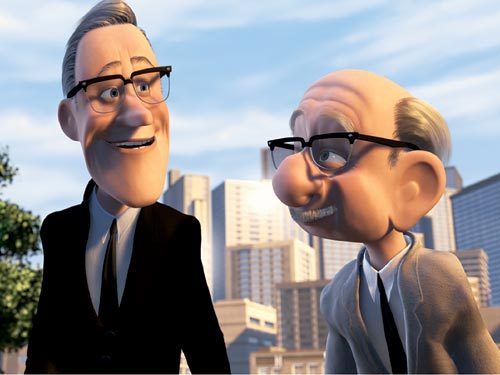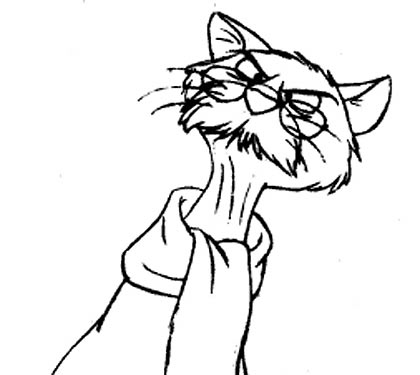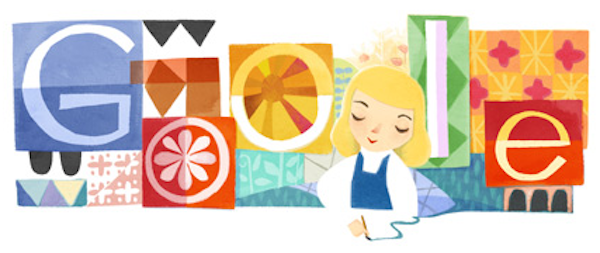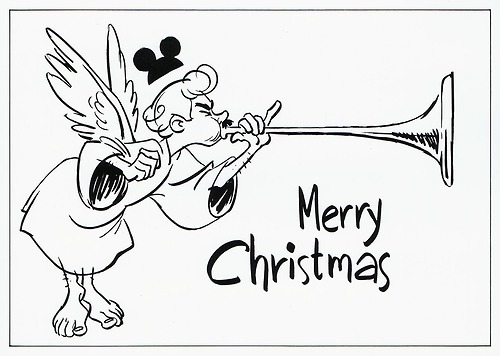Over the years, collecting film posters has become an increasingly popular hobby. Original printings for certain posters of famous movies can go for hundreds or even thousands of dollars. (In 2005, an original poster for Metropolis [1927]) broke all records by
selling for $690,000 to... Leonardo DiCaprio!?) Prior to the 1990s, most posters and flyers were illustrated by hand. Today, posters are primarily made in Photoshop or similarly altered from movie stills or existing pictures, unless, of course, they are for animated films.
Inspired by
similar lists on the internet, here are 25 of the most intriguing posters for famous animated films from over the years in chronological order. (Note: All posters listed here are from the original film release, not reissues, except for the
Alice in Wonderland one. Foreign release posters may be listed, however. Also, the quality of the poster does
not always reflect the quality of the film itself.)
1. Snow White (1937)
Although not the first animated feature ever made, Snow White was certainly the earliest cartoon film to reach international success. It was the also one of the earliest animated films to feature sound and the first to be released in full color. It continues to be a pop-culture icon today, and established the 'fairytale formula' that many Disney films still follow. Even before Snow White was released, Walt's name was already huge. How many other posters can get away with the tagline, "His first feature length production" ?
2. Bambi (1942)
This lovely Italian poster is far more interesting than the
typical over-glossy, saturated box art that Americans audiences have become so accustomed to seeing.
Bambi was the most complexly animated film of its time and required a far greater attention to detail than any other Disney production before it. Live animals were even brought in to the studio to allow for more life-like drawings and a sense of realism. Because of this and the fact that that
Bambi took the risk of killing off the protagonist's mother, it was reputably the film that Walt was most proud of.
3. Alice in Wonderland (1951)
Despite popular belief, Lewis Carroll's story was
never supposed to be about drug use. (This mindset did not arise until, surprise, the counterculture movement of the late 1960s.) Ironically, this wonderfully colorful and 'trippy' poster seems to suggest it might though.
Alice was one of Walt Disney's favorite children's books. He had long tried to make a film of it before, but did not get the chance until later into his career. Interestingly enough,
Alice in Wonderland fared poorly when first released. Critics dismissed it for being too Americanized and it did modestly at the box office. Today, it is regarded as a classic due to its surreal and inspired imagery and art direction by
Mary Blair.
4. Watership Down (1978)
Watership Down is about as similar to a Disney film as
Psycho is to
Wizard of Oz. It remains a testament that just because something is animated, it is not necessarily for children. This flyer, depicting a rabbit caught in a snare, is made immortally haunting by the quote from the folktale of El-ahrairah.
Watership Down can be best described as a allegorical epic dealing with themes such as tyranny, governmental corruption, and the violation of individual rights. (Yes, and it also happens to be about rabbits.) It remains a landmark in British film and is considered to be
one of the greatest cartoons ever made.
5. Lupin the Third: The Castle of Cagliostro (1978)
Even the most causal anime fan is aware of the works of the great
Hayao Miyazaki, who is as just as famous as Disney or Pixar to those in the animation field. After years of working in television, Miyazaki released
The Castle of Cagliostro, the first film he ever directed. Even though it is based off a popular franchise,
Cagliostro manages to be very entertaining and is widely regarded as one of the best adventure films to ever be produced, receiving praise from the likes of Steven Spielberg and John Lasseter. This poster is hilariously nutty. It looks like something made for a
Where's Waldo? book. Several things going on in the background, like a topless lady floating away in a bathtub, don't even happen in the movie!
6. The Lord of the Rings (1978)
First off, this movie is terrible. It's too bad that the poster was a lot cooler than the movie was itself! But the animated version of
Lord of the Rings, for all of its shoddy animation and its poor adaptation of JR Tolkien's novels, remains an interesting piece of film history. Directed by
Ralph Bashki, infamous for creating the first X-rated cartoon film
Fritz the Cat (1972), this version of LOTR represented the growing field of animators who left the studio system to make films of their own. Many of the artists in the
1970s and 1980s in particular, were growing tired of the regime of Saturday mourning, uh... morning, cartoons being cheaply produced and sanitized for young childern.
7. The Secret of NIMH (1982)
What an appropriately dark yet intriguing poster for the film debut of
Don Bluth.
The Secret of NIMH was created by Bluth and a small group of other frustrated ex-Disney animators. It was the first animated film since the late 1950s to have such complex and beautiful animation and featured a somewhat darker and more mature storyline for family audiences to boot. Although
NIMH still remains overlooked by many average film goers, it was
very important for preserving and reviving interest in creating fine animated features. Competition from Bluth's later films would force larger studios, like Disney, to
pull their act together at by the end of the 1980s.
8. Nausicaa of the Valley of the Wind (1984)
Nausicaa is another example of an intelligent film aimed for a somewhat older audience than what most American cartoons are accustomed to. Based of the first third of Miyazaki's
epic manga of the same name, it is about a princess living in a post-apocalyptic world were people are constantly fighting amongst themselves and with the forces of nature.
Nausicaa was so successful it allowed for the establishment of Studio Ghibli, now world famous for its high quality anime films. This poster is highly valued among avid collectors, as it was drawn by Miyazaki himself in vivid watercolors.
9. Laputa: Castle in the Sky (1986)
Speaking of Studio Ghibli, the first film to be released by the studio was Laputa: Castle in Sky. Loosely based off his TV series Future Boy Conan, Miyazaki directed a wonderfully imaginative steam-punk style fantasy about a girl with a mysterious crystal necklace being pursued by the military and a gang of air pirates. Although not initially a hit, Laputa has become a beloved film ever since Miyazaki grudgingly gave into merchandising his characters after the release of Kiki's Delivery Service (1989). The best thing about this poster? Its usage of perspective and complimentary colors.
10. Akira (1988)
Akira is sometimes considered to be the first modern anime by certain people, but this is common misconception by western fans. (The first, in fact, was
Horus: Prince of the Sun made twenty years earlier.)
Akira was, however, the first mature anime to be widely successful with American audiences (and the first major anime to gain widespread attention overseas since the late 1960s- early 1970s). A very violent and unsettling film set in the dystopian future of Tokyo,
Akira was sober warning about motorcycle gang violence common in Japan during the time and government funded research. Even the simple style of the poster comes off as eerie. It focuses on Kaneda's motorcycle, a symbol of status and power. The use of the color red and shades of black and grey emphasize that this is certainly not a cute cartoon to put in front of your kid as a babysitter.
11. My Neighbor Totoro (1988)
The polar opposite of Akira, My Neighbor Totoro has charmed audiences worldwide since its release. It is a family movie that it is truly great for any age, as it does not belittle the intelligence of its audience. This poster is rather unusual. At first glance, it looks exactly like the iconic scene from the movie were sisters Satsuki and Mei wait with Totoro at the bus stop until their father comes home from work. But their is only one girl on the poster, resembling a cross between the two sisters. This was because Totoro was originally going to about one girl. The idea of having the film be about two sisters did not arise until later into production.
12. Grave of Fireflies (1988)
Believe it or not,
Grave of Fireflies was released as a
double bill with
My Neighbor Totoro.
Grave is one of the saddest, but perhaps one of the most important films ever made. Its plot, revolving around two Japanese childern who starve during WWII, has often been compared to that of
Schindler's List (1993). This poster does an excellent job of reflecting the themes of Isao Takahada's film. The way the children stare back at you and menacing shadow of the bomber plane bring up the question, "When is war necessary, and at what cost?"
13. The Little Mermaid (1989)
The Little Mermaid helped Disney recover from its financial and creative hiatus. Although the movie took several liberties from the original fairytale by Hans Christian Anderson, it continues to be an audience favorite. (Then again, can you imagine how people would react to Disney releasing a version close to
the dark original with suicide and all?) Unlike
this ugly and somewhat controversial poster, the flyer depicted here is quite nice. The simplicity and primary use of shades of blue of the image hint at Ariel's sense of longing.
14. The Nightmare Before Christmas (1992)
Although
The Nightmare Before Christmas is commonly misattributed to Tim Burton, it was actually directed by
Henry Selick (the man behind
James and the Giant Peach [1996] and
Coraline [2009]).
Nightmare was produced and co-written by Burton, however. At any rate, the film received lukewarm reception when first released, perhaps due to its unorthodox style for an American cartoon. But a cult following of the
Nightmare grew, and it has been well received ever since then. This poster, thus, has become buried into many people's minds. Its opposing color scheme and twisted imagery make it particularly memorable.
15. Aladdin (1992)
Aladdin is a very fun and goofy film. In some ways, it seems more like a Warner Bros. production than a Disney cartoon, which may explain why
Chuck Jones considered it to be 'one of the funniest films ever made.' This makes
Aladdin's original poster all the more curious. The poster has very simple, but appealing style to it and has a more serious feel about it. Perhaps this was because Disney decided to design it as '
Oscar bait' to appeal to the Academy after
Beauty and the Beast (1991) was nominated for best feature? The Genie, arguably
Aladdin's most memorable character, is not even on the poster. This might be because Robin Williams did not want his image to be overexploited by Disney. However,
Disney would later break their agreement with Williams stating that his portrayal of Genie would not take up more than 25% of adverting space.
16. Toy Story (1995)
The original
Toy Story broke several records upon its release. It was the first fully CGI film to ever be released and was an example of the growing number of successful Non-Disney animated films. John Lasseter wisely made the decision to have the film star inanimate objects in order to avoid the issue of the
uncanny valley, which happened previously in the Pixar short
Tin Toy (1988). The poster depicted here is good example of how to use perspective for dramatic effect.
17. The Hunchback of Notre Dame (1996)
Alongside
The Black Cauldron (1985), this film has become sort of the 'black sheep' of Disney movies.
The Hunchback of Notre Dame is certainly not a perfect film, but it should be acknowledged for its effort to go outside of Disney's comfort zone. How many other G-rated films deal with issues such as corruption in the church, infanticide, lust, and social injustice? This appropriately somewhat solemn and lovingly illustrated poster was created by
John Alvin. He was well known for also making flyer art for other Disney Renaissance films,
The Gremlins,
Alien,
ET, and
Blade Runner, just to name a few.
18. Princess Mononoke (1997)

The spiritual successor to
Nausicaa of the Valley of the Wind,
Princess Mononoke was the first Studio Ghibli film to become widely available outside of Japan in an unaltered format. (
Nausicaa had the
unfortunate experience of being horrendously dubbed and having its length cut by half an hour to make it 'more marketable' to US audiences during the 1980s.)
Mononoke's complex plot avoids many problems associated with other environmentally themed films such as
Pocahontas and
Avatar. Neither side of the argument (San, the girl raised by wolves, and Lady Eboshi of Iron Town) is shown to be more right or wrong than the other. The protagonist Ashitaka and the audience is left torn between both parties. The lose of innocence and unclear answer to how humans and nature can coexist peacefully are at the heart of this film. The poster, with San angrily glaring at anyone happening to be passing by, also features the immortal quote "Ikiro!" ("We must try to live."), referencing back to Miyazaki's earlier films and own philosophy.
19. Perfect Blue (1997)
Satoshi Kon was a very talented anime director known for his complex and confusing films that dealt with insanity, betrayal, and social injustice. His first, and perhaps most adult, film was
Perfect Blue, about a retired pop-star who begins to lose her sense of reality as she is stalked by an over obsessive fan. It should be noted that this film has won wide spread acclaim, including from Terry Gilman. Perfect Blue also was a huge influence on the direction of
Black Swan (2010) and both have very similar plot lines. So much so, in fact, that
some question as to why director Darren Aronofsky bought rights to the film. This poster was made for French audiences. It really evokes the bizarreness of the film and the psychological horror that Mima faces. It refers to the scene where Mima hallucinates that someday broke into her home and her fish have all died.
20. The Prince of Egypt (1998)
Before switching entirely over to CGI, Dreamworks released several traditionally animated movies during the late 1990s and early 2000s. The best of these films was The Prince of Egypt. Although the film has been compared to The Ten Commandments (1956), it is uniquely its own and really should be seen by anyone who wants to enjoy a modern example of a large scale epic. This promo's use of heavy contrast and warm hues seem to hint that some great change is about to come.
21. The Iron Giant (1999)
The Iron Giant was one of those films that was ahead of its time. Directed by the now famous
Brad Bird,
The Iron Giant is about a smart but misfit boy, Hogarth, who happens to strike up a friendship with a large amnesiac robot that fell to Earth. Since the film is set during the Cold War, Hogarth must hide his new and unusual friend who is misunderstood by the paranoid world around him.
The Iron Giant failed at the box office when first released, perhaps due to poor marketing or its unconventional plot, but has sense gone on to become a modern classic. Cartoon Network even used to play the film regularly as a Thanksgiving tradition. The simple silhouette style of this poster is really striking. The only color part of the giant is his large yellow eyes, which appear to be almost sad or lonely.
22. Tokyo Godfathers (2003)
Tokyo Godfathers was the second to last film produced by the late Satoshi Kon and the most 'realistic' of his works. This US poster introduces the audience to the movie's rather unusual protagonists (a transvestite, runaway girl, and an alcoholic) all of whom are homeless. When the three happen to come across a baby in the dumpster on Christmas Eve, they decide that they must return her to her mother. This results in a sometimes hilarious, and sometimes rather sad or touching, journey of self-discovery for the protagonists as they uncover each other's pasts and meet many interesting people along the way. The warm colors of this poster sort of evoke that of Christmas movie, but the focus of the poster poster clearly remains on the ragtag protagonists. The baby is also depicted with a sort of glow around her, suggesting the 'miracles' she brings into the protagonists lives.
23. Ratatouille (2007)
Another excellent film by the talented Brad Bird, this poster for Ratatouille really shows how far computer technology has come from making Toy Story over ten years prior. This poster has been used for many international promotions. (A clear copy of the English version is unavailable, so we will make do with this one.) The bright color scheme and realistic carrot are enough to make audiences hungry just by looking at it. Remy seems to be enjoying the smell of the food, but perhaps a bit too much. It almost looks like he is in love with the carrot!
24. Waltz with Bashir (2008)
Waltz with Bashir is one of the most important and harrowing films to come from an indie studio recently. Filmed using a technique similar to rotoscoping, it deals with a Israeli man's post dramatic stress disorder following the
Lebanon War. This poster's minimalist and bleak style are perfectly appropriate. The protagonist of this documentary, Ari Folman, seems to be desperately staring out into space as he searches for answers and tries to recollect his disturbing memories of war.
25. The Secret World of Arrietty (2010)
Studio Ghibli just seems to have a thing for making lovely promotional artwork. This is technically
Arriety's French poster, but it is partially identical to the original Japanese film. (For some reason, the internet seems to be lacking a clear scan of the original poster.) It is a far cry from the
poster designed for American audiences, which seems to suffer from over saturation and stiff poses. (Sho's eyes and disembodied head are also sort of creepy...) Very few films evoke such a grand sense of scale and attention to small detail as
Arriety does, which is only fitting since the titular character is only a couple inches high.
















































